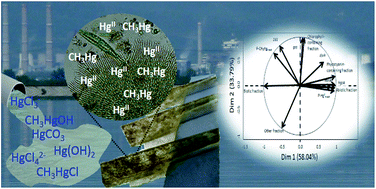Influence of chemical speciation and biofilm composition on mercury accumulation by freshwater biofilms†
Abstract
Mercury (Hg) is a pollutant of high concern for aquatic systems due to the biomagnification of its methylated form along the food chain. However, in contrast to other metals, gaining knowledge of its bioavailable forms for aquatic microorganisms remains challenging, making Hg risk assessment difficult. Ubiquitous and sessile freshwater biofilms are well known to accumulate and to transform Hg present in their ambient environment. The present study thus aims to evaluate whether non-extractable (proxy of intracellular) Hg accumulated by biofilms could be a good indicator of Hg bioavailability for microorganisms in freshwater. To that end, the link between Hg concentration and speciation, as well as biofilm composition (percentage of abiotic, biotic, chlorophyll and phycocyanin-fractions and abundance of dsrA, gcs, merA and hgcA bacterial genes) and biofilm Hg accumulation was examined. The studied biofilms were grown on artificial substrata in four reservoirs along the Olt River (Romania), which was contaminated by Hg coming from chlor-alkali plant effluents. The 0.45 μm-filterable Hg concentrations in ambient waters were measured and inorganic IHg speciation was modelled. Biofilms were analyzed for their non-extractable IHg and methylmercury (MeHg) contents as well as for their composition. The non-extractable IHg content was related, but not significantly, to the concentration of total IHg (r2 = 0.88, p = 0.061) whereas a significant correlation was found with the predicted IHg concentration that is not bound to dissolved organic matter (r2 = 0.95, p = 0.027), despite its extremely low concentrations (10−25 M), showing a limitation of the thermodynamic Hg modelling to predict Hg bioavailability. The studied biofilms were different in biomass and composition and a principal component analysis showed that the non-extractable IHg content correlated with the abundance of the merA and hgcA genes, while MeHg accumulation was only linked with the abundance of the rRNA 16S gene. The present study suggests that non-extractable IHg concentrations in biofilms are a useful proxy of IHg bioavailable forms in waters whereas the hgcA and merA genes are good biomarkers of both biofilm IHg exposure and bioavailability.


 Please wait while we load your content...
Please wait while we load your content...